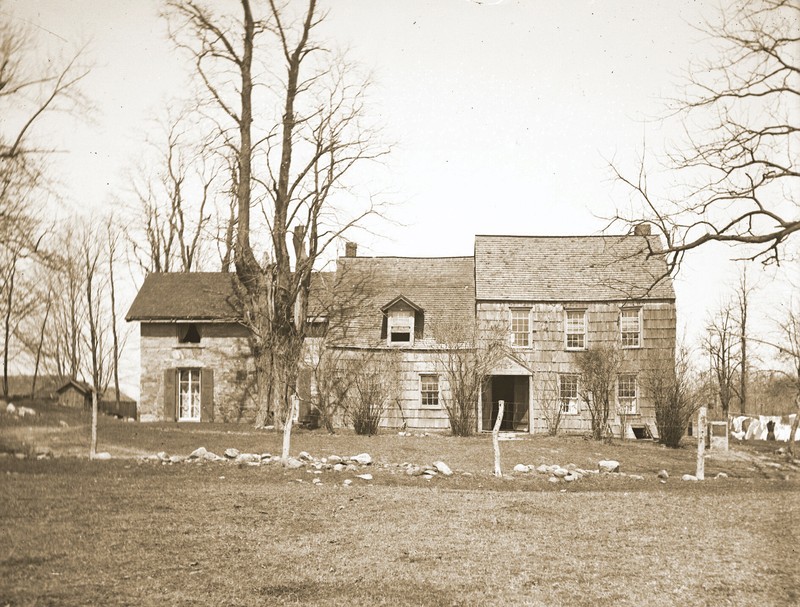Odell House
Introduction
Text-to-speech Audio
Constructed in 1732, the Odell House or Rochambeau Headquarters, served as French headquarters for a unit of five thousand men during the Revolutionary War. While the structure itself has no outstandingly architectural features, the stories of its residents, and its use by the Count Rochambeau during the war for independence gives this small home immense historical meaning.
Images
Odell House Exterior (Exact Date Unknown)

Odell House Exterior (Exact Date Unknown)

Odell House Drawing

Odell House.

Backstory and Context
Text-to-speech Audio
While it was originally constructed in 1732, the Odell house was built in stages over time. Originally, it was a modest residential home that was built by John Tompkins of Eastchester and located in an area surrounded by locust trees and woods. Tompkins eventually built another house further north in 1760 and decided to make the home a “tenant farmstead of Philipsburg Manor, one of the largest and richest manors of its time.”1
The structure itself is “a composite structure with varying roof heights.”2 The original single-story portion of the home was constructed in 1732 as mentioned, with a eastern wing added in 1765 that brought it to a one-half story home until 1785, when the west and eastern wings were raised once again. This would remain relatively untouched until 1855 when a two-story stone west wing was added to the home. Additionally, “the central and east portions of Odell House, on fieldstone foundations, are of wood frame construction covered with cedar shingles. The western wing is constructed of coursed local fieldstone. Shingles cover the gable roofs.”3 The structure also features three divided Dutch doors. Two located on the southern side, with one located to the north.
In regards to the interior of the home, there is only one chimney that is located on the eastern end of the structure. The home's floors have had to have replacements over the years but originally it was constructed with red pine boards of random width, some of these boards can still be found. “All walls are covered with plaster, and, in some areas, the plaster is laid directly on the original wattle and daub.”4 Original mantles and molding are also still present in the home with much of the interior and exterior being modeled in the Dutch fashion. There is interest in the structure because much of its original eighteenth century aspects are still in place even in the twenty-first century. With time the structure has started to degrade but it is currently being restored.
Following Tompkins' ownership of the home, Gilbert Bates occupied it from 1760 to 1785. But unfortunately “Bates himself had been captured by the British early in the war and, like many another unfortunate prisoner, had died in captivity.”5 Ownership then went to his wife who sold the property to Col. John Odell, hence the name Odell House. “A local hero, Odell is known for having served as Lieutenant in the Westchester Guides during the Revolution, and for having been a member of a family established in Westchester by 1662.”6 It was in Odell family ownership until 1965 when the property was given to the Sons of the American Revolution.
“Odell farm is particularly well-known as the Headquarters of Count de Rochambeau and campsite for the French expeditionary forces under his command between July 6-August 18, 1781. Here, Washington and Rochambeau forged the American and French alliance, and agreed to put the southern plan into effect.”7 Together Rochambeau and Washington created a plan at the Headquarters to deceive the British into believing that there would be an attack on New York City while they moved their forces elsewhere. “They were well on their way to Virginia before they could be intercepted. With Lafayette, they trapped Cornwallis at Yorktown.”8 This capture led to the surrender of Cornwallis which ultimately led to the final victory of the Revolution.
The home has many stories to share of stories across the centuries. With work underway to restore the structure, the public will be able to experience an important piece of colonial history in Westchester County. Odell House was added to the National Register in 1973.
Cite This Entry
Davis, Barbara and Patrick Raftery on behalf of Westchester County Historical Society. "Odell House ." Clio: Your Guide to History. February 9, 2022. Accessed March 13, 2025. https://theclio.com/entry/101921
Sources
- Rennenkampf, Lenore M.. Odell House. National Register of Historic Places Inventory. Published February 1st 1973.
- Rennenkampf, Lenore M.. Odell House. National Register of Historic Places Inventory. Published February 1st 1973.
- Rennenkampf, Lenore M.. Odell House. National Register of Historic Places Inventory. Published February 1st 1973.
- Rennenkampf, Lenore M.. Odell House. National Register of Historic Places Inventory. Published February 1st 1973.
- Williams, Gray. Picturing Our Past: National Register Sites in Westchester County . Elmsford , NY. Westchester County Historical Society , 2003.
- Rennenkampf, Lenore M.. Odell House. National Register of Historic Places Inventory. Published February 1st 1973.
- Rennenkampf, Lenore M.. Odell House. National Register of Historic Places Inventory. Published February 1st 1973.
- Williams, Gray. Picturing Our Past: National Register Sites in Westchester County . Elmsford , NY. Westchester County Historical Society , 2003.
Westchester County Historical Society.
https://www.odellrochambeau.org/
https://www.odellrochambeau.org/
Westchester County Historical Society. Photo by Gray Williams.

